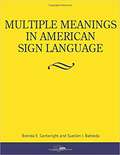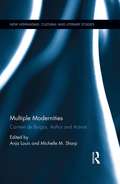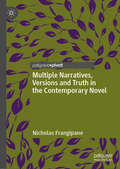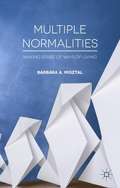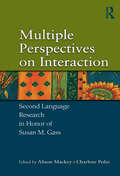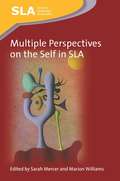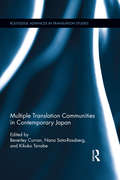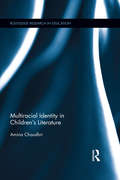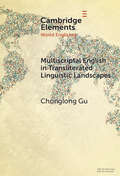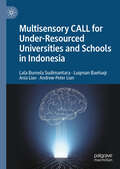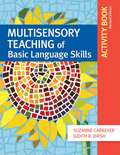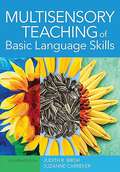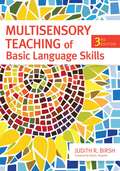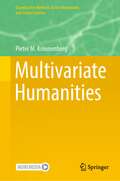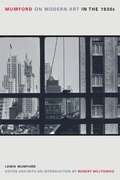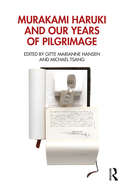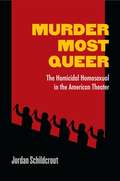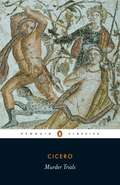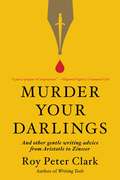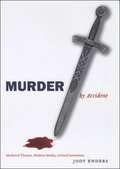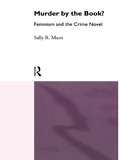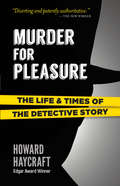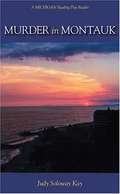- Table View
- List View
Multiple Meanings in American Sign Language
by Brenda E. Cartwright Suellen J. BahledaThere are a variety of ways one can use this book to improve one's signing and interpreting skills. Teachers and students may choose to explore one particular unit or a variety of elements from different units. This book assists in developing and practicing a process for analyzing the meaning of specific English words and phrases so that one can create accurate equivalents in ASL. It is crucial that learners avoid the temptation to hurry through any exercise, even when a word or phrase seems easy or obvious. By taking the time to analyze and determine the meanings of the various words and phrases in the exercises within this book, a process for analyzing meaning emerges which serves as a foundation for analyzing the meaning of English words and phrases and translating this meaning accurately, efficiently and proficiently into ASL.
Multiple Modernities: Carmen de Burgos, Author and Activist (New Hispanisms: Cultural and Literary Studies)
by Michelle Sharp Anja LouisThis collection of essays confirms Carmen de Burgos’s pivotal place in Spanish feminist history by bringing together eminent international scholars who offer new readings of Burgos’s work. It includes the analyses of a number of lesser-known texts, both fictional and non-fictional, which give us a more comprehensive examination of Burgos’s multipronge feminist approach. Burgos’s works, especially her essays, are essential feminist reading and complement other European and North American traditions. Gaining familiarity with the breadth and depth of her work serves not only to provide an understanding of Spanish firstwave feminism, but also enriches our appreciation of cultural studies, gender studies, subaltern studies and travel literature. Looking at the entirety of her life and work, and the wide-ranging contributions in this volume, it is evident that Burgos embodied the tensions between tradition and modernity, depicting multiple representations of womanhood. Encouraging women to take ownership of their personal fashion, the design of their homes and the decorum of their families were steps towards recognizing a female population that was cognizant of its own desires.
Multiple Narratives, Versions and Truth in the Contemporary Novel
by Nicholas FrangipaneMultiple Narratives, Versions and Truth in the Contemporary Novel considers the shifting perception of truth in fiction. Nicholas Frangipane examines the narrative technique of telling multiple versions of the same sets of events, presenting both true and false versions of the events within a fictional work. This book looks closely at these “Reflexive Double Narratives” in order to understand the way many contemporary writers have attempted to work past postmodernism without forgetting its lessons. Frangipane explores how writers like Ian McEwan, Yann Martel and Alice Munro have departed from the radical experimentation of their predecessors and instead make sincere attempts to find ways that fictional writing can reveal enduring truths, and in so doing, redefine the meaning of “truth” itself and signal the emergence of post-postmodernism.
Multiple Normalities
by Barbara A. MisztalMultiple Normalities: Making Sense of Ways of Living enhances sociological understandings of normality by illustrating it with the help of British novels. Barbara A. Misztal conceptualizes the notion of normality as the frame through which people see and interpret their particular historical circumstances. Assuming that literature constitutes a kind of knowledge about the experience of the social world which is complementary to sociological knowledge, it investigates the representations ofnormality in prize-winning novels published between 1950 and 1970 and between 1990 and 2010. Multiple Normalities analyzes the novels in terms of how their central images of normality demonstrate commonalities and differences between the meanings of normality in the two different periods, as well as changes in the experience of a sense of normality in the last sixty years. Misztal, by illustrating the emergence of multiple normalities, demonstrates the transformation of ways in which we give meaning to the world.
Multiple Perspectives on Interaction: Second Language Research in Honor of Susan M. Gass
by Alison Mackey Charlene PolioThis volume in honor of Susan M. Gass focuses on interaction in second language acquisition from multiple perspectives. International experts in the field of SLA contribute insights and explanations on the interaction approach's compatibility with other theoretical approaches, key empirical studies, interaction in specific contexts, and future directions. Readers will find an enriching discussion of how the interaction research tradition is viewed in a wide range of different approaches to learning and teaching second languages.
Multiple Perspectives on the Self in SLA
by Marion Williams Sarah MercerInstead of viewing different perspectives on the self as competing with each other and considering one perspective on the self as being inherently 'better' than another, this book takes the view that a fuller, more comprehensive picture of the self in SLA can be gained by examining and combining insights from different perspectives. This original collection of papers thus attempts to provide a thorough overview of the ways in which the self can be conceptualised in SLA contexts. The editors have brought together a diverse range of theoretical perspectives on the self to allow the reader to appreciate the insights that each approach contributes to overall understandings of the self in the domain of second language acquisition and foreign language learning.
Multiple Translation Communities in Contemporary Japan (Routledge Advances in Translation and Interpreting Studies)
by Nana Sato-Rossberg Beverley Curran Kikuko TanabeMultiple Translation Communities in Contemporary Japan offers a collection of essays that (1) deepens the understanding of the cultural and linguistic diversity of communities in contemporary Japan and how translation operates in this shifting context and circulates globally by looking at some of the ways it is theorized and approached as a significant social, cultural, or political practice, and harnessed by its multiple agents; (2) draws attention to the multi-platform translations of cultural productions such as manga, which are both particular to and popular in Japan but also culturally influential and widely circulated transnationally; (3) poses questions about the range of roles translation has in the construction, performance, and control of gender roles in Japan, and (4) enriches Translation Studies by offering essays that problematize critical notions related to translation. In short, the essays in this book highlight the diversity and ubiquity of translation in Japan as well as the range of methods being used to understand how it is being theorized, positioned, and practiced.
Multiracial Identity in Children's Literature: Reading Diversity In the Classroom (Routledge Research in Education #185)
by Amina ChaudhriRacially mixed children make up the fastest growing youth demographic in the U.S., and teachers of diverse populations need to be mindful in selecting literature that their students can identify with. This volume explores how books for elementary school students depict and reflect multiracial experiences through text and images. Chaudhri examines contemporary children’s literature to demonstrate the role these books play in perpetuating and resisting stereotypes and the ways in which they might influence their readers. Through critical analysis of contemporary children’s fiction, Chaudhri highlights the connections between context, literature, and personal experience to deepen our understanding of how children’s books treat multiracial identity.
Multiscriptal English in Transliterated Linguistic Landscapes (Elements in World Englishes)
by Chonglong GuIn this monograph, 'multiscriptal English' is theorised. Unorthodox and unconventional this may sound, a salient sociolinguistic reality is emerging globally. That is, while standardised English (Roman script) is routinely taught and used, English in superdiverse, multilingual, and/or (post)colonial societies is often camouflaged in local scripts and 'passes off' as local languages in these places' linguistic landscapes through transliteration (at lexical, phrasal and sentential levels). To illustrate, documentary evidence from Arabic, Malay (Jawi), Nepali, Urdu, Tamil, Korean, Japanese, Russian, Thai, etc. is presented. Through inter-scriptal rendition, English is glocalised and enshrined in seemingly 'exotic' scripts that embody different socio-political and religious worldviews. In the (re)contextualisation process, English inevitably undergoes transformations and adopts new flavours. This gives English a second life with multiple manifestations/incarnations in new contexts. This points to the juggernaut of English in our globalised/neoliberal world. The existence of multiscriptal English necessitates more coordinated and interdisciplinary research efforts going forward.
Multisensory CALL for Under-Resourced Universities and Schools in Indonesia
by Ania Lian Lala Bumela Sudimantara Luqman Baehaqi Andrew-Peter LianThis book showcases the successful integration of multisensory learning and computer-assisted language learning (CALL) in under-resourced schools and universities in Indonesia, aimed at addressing the learning crisis as indicated by the sharp decline of English Proficiency Index and PISA in the last two decades. Multisensory learning provides a well-rounded learning experience that helps students to accelerate their learning. The authors describe how brain-informed learning tools, such as the Verbotonal Approach, Reading for Emotions, and Aesthetics, can facilitate rich and engaging learning practices, and argues that adopting these practices can allow students to take a more active role in their learning, resulting in improved outcomes. This book will be of interest to readers in the Indonesian and other similar contexts, particularly those with an interest in language education, applied linguistics, CALL and TESOL.
Multisensory Teaching Of Basic Language Skills Activity Book
by Suzanne Carreker Judith R. BirshWith the new edition of this activity book--the companion to Judith Birsh's bestselling text, Multisensory Teaching of Basic Language Skills--students and practitioners will get the practice they need to use multisensory teaching effectively with students who have dyslexia and other learning disabilities. Ideal for both pre-service teacher education courses and in-service professional development, the activity book aligns with the third edition of the Multisensory Teaching textbook, so readers can easily use them in tandem.
Multisensory Teaching of Basic Language Skills
by Suzanne Carreker Judith R. BirshKeep up with the latest on the highly respected multisensory teaching approach to literacy with this new fourth edition, a complete update of the bestselling textbook adopted in colleges and universities across the country. The most comprehensive text available on multisensory teaching, this book prepares today's educators to use specific evidence-based approaches that improve struggling students' language skills and academic outcomes in elementary through high school. <P><P> Educators will get rich background information on the systems and structures of the English language, plus a deep dive into the what and how of Structured Literacy Instruction. They'll also find practical strategies and guidelines on all aspects of language and literacy instruction, including planning effective lessons, connecting research with practice, conducting and interpreting assessment, understanding the emotional side of learning disabilities, and more. An essential reference and professional development resource to keep and use for years to come, this book gets educators ready to be thoughtful, skilled, and compassionate teachers of reading and language arts.
Multisensory Teaching of Basic Language Skills (3rd Edition)
by Judith R. BirschAs new research shows how effective systematic and explicit teaching of language-based skills is for students with learning disabilities—along with the added benefits of multisensory techniques—discover the latest on this popular teaching approach with the third edition of this bestselling textbook. Adopted by colleges and universities across the country, this definitive core text is now fully revised and expanded with cutting-edge research and more on hot topics such as executive function, fluency, and adolescent literacy. The most comprehensive text available on multisensory teaching, this book shows preservice educators how to use specific multisensory approaches to dramatically improve struggling students' language skills and academic outcomes in elementary through high school.
Multivariate Humanities (Quantitative Methods in the Humanities and Social Sciences)
by Pieter M. KroonenbergThis case study-based textbook in multivariate analysis for advanced students in the humanities emphasizes descriptive, exploratory analyses of various types of data sets from a wide range of sub-disciplines, promoting the use of multivariate analysis and illustrating its wide applicability. Fields featured include, but are not limited to, historical agriculture, arts (music and painting), theology, and stylometrics (authorship issues). Most analyses are based on existing data, earlier analysed in published peer-reviewed papers.Four preliminary methodological and statistical chapters provide general technical background to the case studies. The multivariate statistical methods presented and illustrated include data inspection, several varieties of principal component analysis, correspondence analysis, multidimensional scaling, cluster analysis, regression analysis, discriminant analysis, and three-mode analysis.The bulk of the text is taken up by 14 case studies that lean heavily on graphical representations of statistical information such as biplots, using descriptive statistical techniques to support substantive conclusions. Each study features a description of the substantive background to the data, followed by discussion of appropriate multivariate techniques, and detailed results interpreted through graphical illustrations. Each study is concluded with a conceptual summary.
Mumford on Modern Art in the 1930s
by Lewis MumfordAlthough Lewis Mumford is widely acknowledged as the seminal American critic of architecture and urbanism in the twentieth century, he is less known for his art criticism.
Murakami Haruki and Our Years of Pilgrimage
by Michael Tsang Gitte Marianne HansenThis book is a timely and expansive volume on Murakami Haruki, arguably Japan's most high-profile contemporary writer. With contributions from prominent Murakami scholars, this book approaches the works of Murakami Haruki through interdisciplinary perspectives, discussing their significance and value through the lenses of history; geography; politics; gender and sexuality; translation; and literary influence and circulation. Together the chapters provide a multifaceted assessment on Murakami’s literary oeuvre in the last four decades, vouching for its continuous importance in understanding the world and Japan in contemporary times. The book also features exclusive material that includes the cultural critic Katō Norihiro’s final work on Murakami – his chapter here is one of the few works ever translated into English – to interviews with Murakami and discussions from his translators and editors, shedding light not only on Murakami’s works as literature but as products of cross-cultural exchanges. Murakami Haruki and Our Years of Pilgrimage will prove a valuable resource for students and scholars of Japanese studies, comparative and world literature, cultural studies, and beyond.
Murder Most Queer: The Homicidal Homosexual In The American Theater
by Jordan SchildcroutThe "villainous homosexual" has long stalked America's cultural imagination, most explicitly in the figure of the gay murderer, a character in dozens of plays. But as society's understanding of homosexuality has changed, so has the significance of these controversial characters, especially when employed by gay theater artists themselves to explore darker fears and desires. "Murder Most Queer" examines the shifting meanings of murderous gay characters in American theater over a century, showing how these representations wrestle with and ultimately subvert notions of gay villainy. "Murder Most Queer" works to expose the forces that create the homophobic paradigm that imagines sexual and gender nonconformity as dangerous and destructive and to show how theater artists--and for the most part gay theater artists--have rewritten and radically altered the significance of the homicidal homosexual. Jordan Schildcrout argues that these figures, far from being simple reiterations of a homophobic archetype, are complex and challenging characters who enact trenchant fantasies of empowerment, replacing the shame and stigma of the abject with the defiance and freedom of the outlaw, giving voice to rage and resistance. These bold characters also probe the darker anxieties and fears that can affect gay lives and relationships. Instead of sentencing them to the prison of negative representations, this book analyzes the meanings in their acts of murder, confronting the real fears and desires condensed in those dramatic acts.
Murder Trials
by CiceroCicero's speeches "In Defence of Sextus Roscius of Amerina," "In Defence of Aulus Cluentius Habitus," "In Defence of Gaius Rabirius," "Note on the Speeches in Defence of Caelius and Milo," and "In Defence of King Deiotarus" provide insight into Roman life, law, and history.
Murder Your Darlings: And Other Gentle Writing Advice from Aristotle to Zinsser
by Roy Peter ClarkFrom one of America's most influential teachers, a collection of the best writing advice distilled from fifty language books -- from Aristotle to Strunk and White.With so many excellent writing guides lining bookstore shelves, it can be hard to know where to look for the best advice. Should you go with Natalie Goldberg or Anne Lamott? Maybe William Zinsser or Stephen King would be more appropriate. Then again, what about the classics -- Strunk and White, or even Aristotle himself?Thankfully, your search is over. In Murder Your Darlings, Roy Peter Clark, who has been a beloved and revered writing teacher to children and Pulitzer Prize winners alike for more than thirty years, has compiled a remarkable collection of more than 100 of the best writing tips from fifty of the best writing books of all time. With a chapter devoted to each key strategy, Clark expands and contextualizes the original author's suggestions and offers anecdotes about how each one helped him or other writers sharpen their skills. An invaluable resource for writers of all kinds, Murder Your Darlings is an inspiring and edifying ode to the craft of writing.
Murder and Media in the New Rome
by Thomas SimpsonAn insightful look into the origins of modern Italian media culture by examining a sensational crime and trial that took place in Rome in the late 1870s, when a bloody murder triggered a national spectacle that became the first great media circus in the new nation of Italy, crucially shaping the young state's public sphere and image of itself.
Murder by Accident: Medieval Theater, Modern Media, Critical Intentions
by Jody EndersOver fifty years ago, it became unfashionable--even forbidden--for students of literature to talk about an author's intentions for a given work. InMurder by Accident, Jody Enders boldly resurrects the long-disgraced concept of intentionality, especially as it relates to the theater. Drawing on four fascinating medieval events in which a theatrical performance precipitated deadly consequences, Enders contends that the marginalization of intention in critical discourse is a mirror for the marginalization--and misunderstanding--of theater. Murder by Accidentrevisits the legal, moral, ethical, and aesthetic limits of the living arts of the past, pairing them with examples from the present, whether they be reality television, snuff films, the "accidental" live broadcast of a suicide on a Los Angeles freeway, or an actor who jokingly fired a stage revolver at his temple, causing his eventual death. This book will force scholars and students to rethink their assumptions about theory, intention, and performance, both past and present.
Murder by the Book?: Feminism and the Crime Novel
by Sally Rowena MuntMurder by the Book? is a thorough - and thoroughly enjoyable - look at the blossoming genre of the feminist crime novel in Britain and the United States. Sally Munt asks why the form has proved so attractive as a vehicle for oppositional politics; whether the pleasures of detective fiction can be truly transgressive; and when exactly it was that the dyke detective appeared as the new super-hero for today. Along the way Munt poses some critical questions about the relations between fiction and activism, politics and representations, the writer and the reader. This will be an enticing book both for addicts of the genre and for teachers and their students.
Murder for Pleasure: The Life and Times of the Detective Story
by Howard Haycraft"Genuinely fascinating reading."—The New York Times Book Review "Diverting and patently authoritative."—The New Yorker "Grand and fascinating … a history, a compendium and a critical study all in one, and all first rate."—Rex Stout "A landmark … a brilliant study written with charm and authority."—Ellery Queen "This book is of permanent value. It should be on the shelf of every reader of detective stories."—Erle Stanley Gardner Author Howard Haycraft, an expert in detective fiction, traces the genre's development from the 1840s through the 1940s. Along the way, he charts the innovations of Edgar Allan Poe, Wilkie Collins, and Arthur Conan Doyle, as well as the modern influence of George Simenon, Josephine Tey, and others. Additional topics include a survey of the critical literature, a detective story quiz, and a Who's Who in Detection.
Murder in Montauk
by Judith KayCharlie Anderson, a reporter on leave from the Boston Globe, becomes entangled in an unusual mystery when he stumbles upon a news article about his own death. Confused and still very much alive, Charlie travels to Montauk, Long Island, to learn more about the deceased man and learns more about himself in the process. The MICHIGAN Reading Plus Readers are original fiction written for students who wish to improve their reading skills. The MICHIGAN Reading Plus Readers support the need for extensive reading on topics of interest to today's students. The Readers offer students books in the genres of mystery, science-fiction, and romance. Activities that practice vocabulary and reading skills are provided on the companion website.
